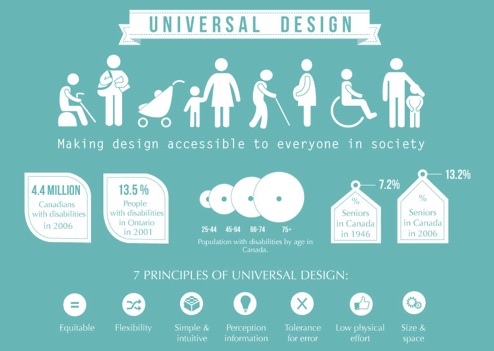Universal Design for Learning (UDL)
Universal Design for Learning is an adaptation of Universal Design, the idea that good design ensured accessibility for all people, regardless of what physical, perceptual or other disabilities they may or may not have. It was created by engineers and architects to help the physically disabled gain access to all public buildings.

Representation
As educators, it's important to allow students to learn new information via the means that best suits them. This could mean reading printed text in a book, hearing the text read aloud in an audio file, experiencing both at the same time (seeing the text while hearing it read aloud), watching a video, or by engaging in a hands-on activity. I try to be sensitive to how individual students best receive information. I alter lessons when necessary to play to their strengths, doing my best to set up an enviroment for their success. The more modalities that can be employed in one classroom lesson, the better.
Many convenience features of airports are examples of how good design benefits not only disabled travelers, but all travelers. Think of how difficult it would be if you were forced to haul your checked and carry-on luggage up actual stairs every time you wanted to get to another floor of the airport. Elevators, moving walkways and escalators aid those with physical disabilities, but they also make the experience of traveling through an airport more efficient for everyone.
The Universal Design concept carries over to education as well. If all learners possess different strength and challenge areas, then it follows that as educators, we should provide opportunities for all students to engage in learning, take in new material and express their learning via the modalities that are most appropriate for them. When we limit the way we present material or ask students to show what they know, we can actually create students with learning disabilities.
UDL IS BASED ON THREE PRINCIPLES:
Why UDL is Important in Learning
If we offer these choices to all students, rather than just the ones that might appear to need alternatives in the form of assistive technologies or modifications, we remove the stigma from students choosing their means of representation, expression or engagement. In doing so, we engender a culture in which differences are normal. These practices reduce the stigma generally attached to differentiation because they promote the idea that differentiation is good for everyone. Attitudes of tolerance and acceptance are good things not only for learning environments, but for society as a whole.
Engagement
By offering choices to students regarding how they can engage with learning materials, we have the highest chance of providing students the best and most effective individualized learning experience. We empower students by allowing them to chose how they wish to engage with new material, whether it's through the vehicle of their interests or through playing to their cognitive strengths. Students can sustain interest this way... even when they hit some rocky patches in the learning process. Allowing for alternative forms of engagement makes the student an active participant in his or her learning.
Action and Expression
What modality helps a student feel most comfortable and adept at demonstrating his or her comprehension of material? Is it via solitary research and writing, working with a partner, creating a poster that includes visuals, making a video or perhaps recording a response? Allowing students to chose empowers them while helping them present their best work.





